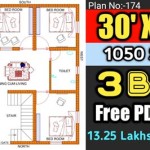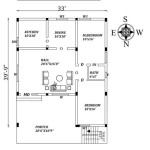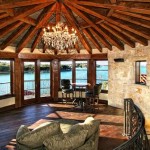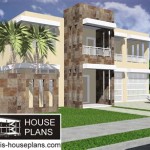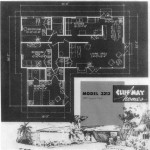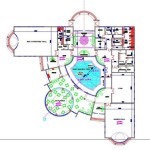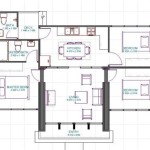House Plans with Interior Courtyards: Design, Benefits, and Considerations
House plans incorporating interior courtyards offer a unique blend of privacy, natural light, and aesthetic appeal, creating a tranquil oasis within the home. These designs are increasingly popular, appealing to homeowners seeking a connection with the outdoors while maintaining a sense of seclusion. The integration of an interior courtyard can fundamentally alter the flow, lighting, and overall atmosphere of a dwelling, adding value not only in terms of monetary worth but also in terms of enhanced living experience.
The concept of an interior courtyard is not new; it has historical roots in various cultures, including Roman, Spanish, and Middle Eastern architecture. Historically, courtyards served practical purposes, such as providing ventilation and a sheltered space for daily activities. Modern interpretations build upon these historical precedents, adapting them to contemporary lifestyles and building materials. This article will explore key aspects of house plans with interior courtyards, encompassing their design considerations, benefits, and factors to consider during the planning process.
Key Considerations in Designing House Plans with Interior Courtyards
Designing a house plan that effectively incorporates an interior courtyard requires careful consideration of several factors. These include the size and shape of the courtyard, its orientation in relation to the sun, the materials used for its construction, and its integration with the surrounding living spaces. A well-designed courtyard seamlessly blends with the home's architecture, enhancing its functionality and aesthetic value.
Size and Shape: The size of the courtyard should be proportionate to the overall size of the house. A small courtyard in a large house might feel insignificant, while an excessively large courtyard in a smaller house could feel disproportionate and consume valuable living space. The shape of the courtyard can also influence its usability. Rectangular courtyards are common, but square, L-shaped, and even round courtyards can be incorporated depending on the architectural style and desired aesthetic. Irregular shapes can introduce visual interest but may present challenges in terms of furniture placement and landscaping.
Orientation and Sun Exposure: The orientation of the courtyard is crucial for maximizing natural light and controlling temperature. A south-facing courtyard will receive the most sunlight throughout the day, which can be advantageous in cooler climates but may require shading strategies in warmer climates. East-facing courtyards receive morning sun, while west-facing courtyards are exposed to afternoon sun. The optimal orientation depends on the local climate and the desired use of the courtyard. Strategies such as strategically placed trees, pergolas, or awnings can be employed to mitigate excessive sun exposure and maintain a comfortable temperature.
Material Selection: The materials used in the construction of the courtyard should complement the overall architectural style of the house and be durable enough to withstand the elements. Common materials include brick, stone, concrete, wood, and stucco. The choice of paving material also plays a significant role in the courtyard's aesthetic and functionality. Options include natural stone, pavers, concrete, and gravel. Landscaping materials, such as plants, trees, and water features, should be carefully selected to create a cohesive and visually appealing space. The materials should also be chosen with maintenance in mind, considering factors such as cleaning requirements and resistance to pests.
Integration with Living Spaces: The courtyard should be seamlessly integrated with the surrounding living spaces to create a harmonious flow. Large windows and sliding doors can provide unobstructed views of the courtyard and allow for easy access. The courtyard can be designed as an extension of the living room, dining room, or kitchen, creating an indoor-outdoor living experience. The floor level of the courtyard should ideally be at the same level as the interior floors to eliminate tripping hazards and create a seamless transition. It is important to consider the acoustic properties of the courtyard materials to minimize noise transfer to the interior living spaces. Thoughtful placement of doors and windows can also promote cross-ventilation, contributing to a more comfortable indoor environment.
Advantages of Incorporating an Interior Courtyard
The incorporation of an interior courtyard in a house plan provides numerous advantages, ranging from enhanced natural light and ventilation to increased privacy and aesthetic appeal. These benefits contribute to an improved living experience and can significantly enhance the value of the property. The advantages extend beyond purely aesthetic considerations, offering practical solutions for climate control and spatial organization.
Enhanced Natural Light and Ventilation: Interior courtyards allow natural light to penetrate deep into the interior of the house, reducing the need for artificial lighting and creating a brighter and more cheerful living environment. The open space of the courtyard also promotes natural ventilation, allowing fresh air to circulate throughout the house and reducing reliance on air conditioning. By strategically placing windows and doors around the courtyard, homeowners can optimize airflow and create a more comfortable and energy-efficient living space. The increased natural light can also have positive effects on mood and well-being.
Increased Privacy: An interior courtyard provides a private outdoor space that is shielded from the street and neighboring properties. This is particularly valuable in urban environments where privacy is often limited. The courtyard can be used for relaxation, outdoor dining, or recreation without the intrusion of outside noise or unwanted attention. High walls, lush landscaping, or strategically placed screens can further enhance the privacy of the courtyard. This private sanctuary offers a respite from the outside world, creating a more tranquil and relaxing living environment.
Improved Aesthetics and Architectural Interest: An interior courtyard adds a unique architectural element that enhances the visual appeal of the house. The combination of indoor and outdoor spaces creates a dynamic and interesting living environment. The courtyard can be customized to reflect the homeowner's personal style and preferences, incorporating features such as water fountains, sculptures, or unique landscaping. The integration of the courtyard can also create striking visual contrasts, highlighting the architectural details of the house and adding depth and character to the overall design. The courtyard becomes a focal point, drawing the eye and creating a sense of serenity and sophistication.
Enhanced Connection to Nature: An interior courtyard allows homeowners to connect with nature even when indoors. The presence of plants, trees, and water features in the courtyard brings the outdoors in, creating a calming and restorative environment. Studies have shown that exposure to nature can reduce stress, improve mood, and enhance overall well-being. The courtyard provides a convenient and accessible space to enjoy the benefits of nature, regardless of the weather or time of day. This connection to nature can significantly enhance the quality of life for residents, fostering a sense of peace and tranquility within the home.
Factors to Consider During the Planning Process
Planning a house with an interior courtyard involves careful consideration of several factors to ensure that the design meets the homeowner's needs and preferences while also adhering to local building codes and regulations. These factors include budget considerations, climate considerations, maintenance requirements, and potential code restrictions. A comprehensive planning process is essential for achieving a successful and functional design.
Budget Considerations: Incorporating an interior courtyard into a house plan can add to the overall cost of construction. The size and complexity of the courtyard, the materials used, and the landscaping chosen will all impact the budget. It is important to establish a realistic budget early in the planning process and to prioritize features and materials accordingly. Consider the long-term costs of maintenance and upkeep when making material selections. Obtaining multiple quotes from contractors and suppliers can help to ensure that the project stays within budget.
Climate Considerations: The local climate should be a primary consideration when designing an interior courtyard. In hot climates, shading strategies are essential to prevent overheating. In cold climates, the courtyard should be designed to maximize solar gain and minimize heat loss. The choice of plants and materials should also be appropriate for the local climate. Consider the prevailing winds and rainfall patterns when designing the drainage system for the courtyard. In areas prone to heavy snowfall, ensure that the courtyard can be easily cleared of snow to prevent damage and maintain access.
Maintenance Requirements: Interior courtyards require regular maintenance to keep them looking their best. This includes cleaning, watering, pruning, and pest control. Choose low-maintenance plants and materials to minimize upkeep. Install an efficient irrigation system to reduce water consumption. Consider the need for drainage to prevent water from pooling in the courtyard. Regular inspections and maintenance can help to prevent minor problems from escalating into major repairs. Proper maintenance will ensure that the courtyard remains a beautiful and functional space for years to come.
Code Restrictions and Regulations: Before beginning construction, it is essential to check local building codes and regulations to ensure that the house plan complies with all applicable requirements. These regulations may address issues such as setbacks, height restrictions, drainage requirements, and accessibility standards. Obtain the necessary permits and approvals before starting any work. Failure to comply with local codes can result in fines, delays, and even the demolition of non-compliant structures. Consulting with a qualified architect or building contractor can help to navigate the complex regulatory landscape and ensure that the project meets all requirements.
House plans with interior courtyards represent a design choice offering a multitude of benefits, ranging from improved natural light and ventilation to increased privacy and aesthetic appeal. Careful planning and consideration of various factors are crucial for creating a functional, sustainable, and visually appealing space that enhances the overall living experience. By integrating the courtyard thoughtfully into the home's design, homeowners can create a tranquil and inviting oasis that complements their lifestyle and adds significant value to their property.

Radical Terrace Pool House Plans Courtyard U Shaped

European Nouveau House Design With Courtyard Plan 4695

Build A House With Courtyard Blog Dreamhomesource Com

Northwest Home With Indoor Central Courtyard 35459gh Architectural Designs House Plans

Interior Courtyard Floor Plan For The Home House Plans

Interior Courtyards In Colombian Houses 15 Examples Of Floor Plans Archdaily

Mcm Design Farm House Plan 1 Courtyard Plans Building A Container Home

Interior Courtyards In Colombian Houses 15 Examples Of Floor Plans Archdaily

5 Modern Houses With Stunning Interior Courtyards

Courtyard House Plans Idyllic Interior

